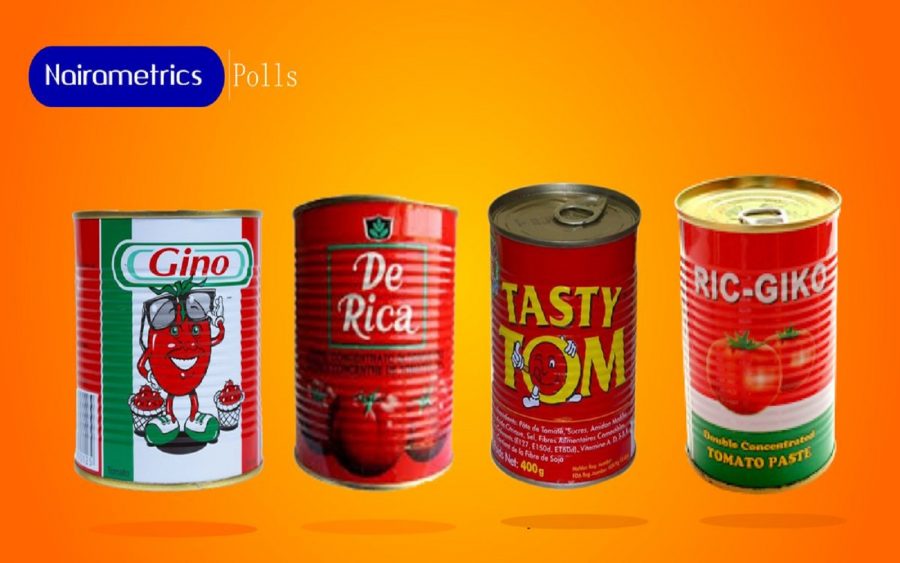Tomato is an important vegetable (technically fruit) rich in the deposit of vitamins, mineral, and iron. It is a good source of lycopene and forms an everyday component of meals in Nigerian households: served in salad, eaten fresh and the main item in stew preparation.
With an estimated annual output of 2.4 million tons, Nigeria is the largest producer of tomatoes in sub Saharan Africa, and ranked 13th in the world.
Due to its short lifespan and seasonal dual trait – periods of plentiful and subsequent shrink period – storage has become a big challenge in the value chain of this rich vegetable/fruit. Although several unconventional storage mechanisms have been deployed in the past, they all proved inadequate and unreliable.
Tomato paste, refined tomato concentrate made into thick paste-like form, packed in tins or sachets, is an alternative to the home-grown produce and a means to augment “inadequate” local production.
On this week’s edition of Product Review, a weekly article where we feature products contending for domination in the highly competitive Nigerian consumer market, we bring to you the various tomato paste brands that are competing for visibility and profitability.
The Entry of Tomato Paste
Although we are not quite sure who made the first legendary leap into the tomato paste market in Nigeria, research shows that most of the early brands in the country were mostly manufactured outside the country.
Currently, there are several brands in the Nigerian market. Various indigenous players have also launched their brands although most of them are still battling to break into the local tomato market due to the high number of already present foreign tomato brands.
The emerging battle for supremacy among brands has pitched foreign brands like Gino, St Rita, Vitalis, to mention a few, against local brands such as Tasty Tom, De Rica, and Festin, produced by Olam International, and Ric Giko and Nagiko tomatoes produced by Erisco Foods Limited. Some others are Sonia Tomato paste produced by Sonia Foods Industries Limited, and Tomato Jos, produced by Tomato Jos Nigeria, which plays in the middle-belt regional market, and has helped heighten competition.
The intense competition has narrowed the lead to just very few brands (Gino, De Rica, Tasty Tom, Sonia, and Ric Giko), while other indigenous brands such as Sonia and Tomato Jos are still struggling to secure their footings in the market. However, in the last few years, Gino has emerged the new king, having wrestled leadership from De Rica which had dominated the market like a colossus for a long time.
According to industry watchers, the manufacturers of De Rica became complacent and its past successes made them too confident and unresponsive to innovations in the market. Although known for its high quality, the product from Olam Group of companies soon went off the market and by the time it returned, Gino had a strong hold of the tomato paste market.
De Rica later had a re-launch campaign in 2012 on the radio with the slogan, “De Rica don come back.” but Gino’s parent company, the Watanmal Group, seems to have perfected the act of designing the company’s offerings such that it occupies a distinctive place in the heart of its consumers.
Why it has been difficult for local brands to compete in this market
The high cost of operating a plant (Power, infrastructure, multiple taxation, etc.) in the country has caused several local manufacturers to close shop, while the foreign brands keep thriving.
In 2016, Nigeria’s biggest tomato paste plant, Erisco Foods Limited, began the process of shutting down its $150 billion plant, resulting in reduced output per production. This decision was informed by what the company’s CEO, Eric Umeofia, called lack of Government support. Nigeria was at this time embroiled in a serious economic contraction which was caused by poor oil prices, low foreign reserves, and high exchange rates.
Manufacturing companies like Erisco Foods Limited struggled to access foreign exchange. This is despite the Government’s effort to provide forex windows for investors and exporters.
What consumers are saying
Nairametrics carried out a survey at Ipodo market in Ikeja to feel the pulse of consumers and traders on their dispositions to these brands.
Many of the traders attributed Gino’s popularity to its long existence in the market, unique taste, thickness, and distinct red color. Though some do so for emotional reasons, as they could not find reasons for their preference.
According to a trader at the market, Iya Ibeji, the average price of tomato paste (Gino) on sale in the open market is N50. A roll made up of 5 is pegged at N250, bringing the cost of a carton to N2200 – N2300. On the other hand, a carton of rival brand, Tasty Tom, goes for N2000 while unit price remains same across board.
A store owner at Agege, a suburb of Lagos, said that Gino has long overtaken De Rica.
“Gino is the fastest selling tomato paste. I don’t know why they buy it, but that is what most of my customers buy.”
Another retailer, simply identified as Iya Lati also corroborated this claim, but described the rate at which the price is being increased by the brand owners as alarming. She disclosed, “I cajole buyers to go for other new brands like Immaculate because I have to make sales.”
For die-hard De Rica loyalists like Mrs. Joy, their reasons range from the sweet taste and red color, to the absence of sour taste obtained in other brands.
“It is not sour, unlike other brands such as Gino.”
Interestingly, besides Gino and De Rica, no other brand stood out as contenders in the tomato paste market, so brands like Tasty Tom and Ric Giko got lost in the sea of other “minor” brands.
Verdict
In a Twitter poll conducted by Nairametrics, Gino got 52%, De Rica got 39%, while Tasty Tom and Ric Giko scored 6% and 3% respectively.
Which of these is your favorite brand and what do you look out for when buying?
Vote, comment, and RT #Nairametrics #NairametricsPoll
— Nairametrics (@Nairametrics) September 11, 2018
Nairametrics observed that consumers will always go for the brand which affords tasty and brilliant redness.
The Gino brand does not seem ready to loosen its firm grip on its leadership position in the market as it recently introduced Gino Pepper and onion mix, thus giving consumers the option of picking between ordinary Gino and the new variant.
But will De Rica regain the leadership position? This depends on how soon it wants it. De Rica must buckle down and improve on its offering unless it is solely dependent on time and chance.
Addittional research by Ibukunoluwa Samuel





















hmmm so which country is producing Gino…cos Gino is making sense…
India
Thanks for this laudable efforts.
Gino sachets are produced locally and being a strong brand, they are not relenting.
The secret of this brand is commitments of the factory and the marketing team.
Am sure the team will sustain their leadership position.
Gino Magic Peppe & Onion and Gino mix make a lot of sense especially when used for jollof rice , stew or any pepper soup.In fact, it is all-in-one for students in tertiary institutions
How do I get the contacts to call/address for their distributors in Owerri IMO state, a business I want to go into thanks.
To me ric-giko remains the best. It doesn’t slap, it’s made of fresh Tomato which is the real thing we need.